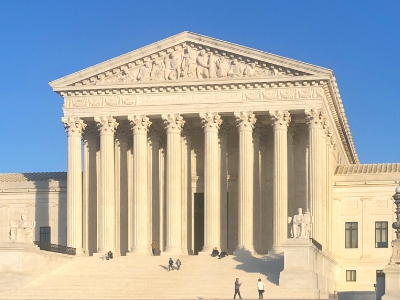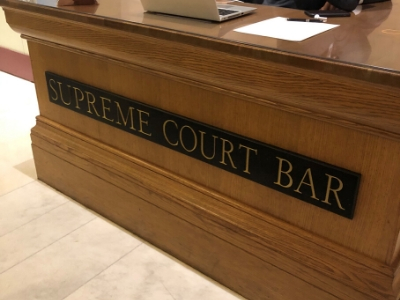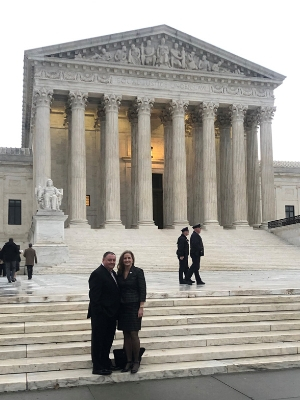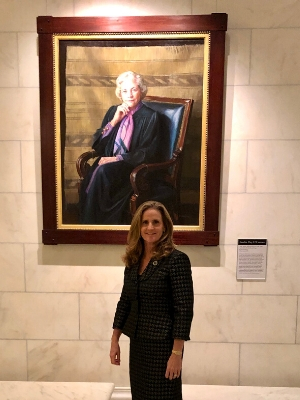
By Leslie Craig Henderzahs
As originally appeared in the December 2019 issue of Res Gestae
The Indiana State Bar Association paves the way for its members to enjoy the rich and rewarding admission experience to the Supreme Court of the United States, and as of this writing, I have just returned from Washington, D.C., as a newly minted member of the Supreme Court bar. In fact, I was seated less than a “first down” away from the greatest legal minds in the country!
The day included breakfast in a private Supreme Court conference room, which included a courtyard, accompanied by the Clerk of the Court and Hoosier George T. Patton Jr., the appellate practitioner who kindly served as the movant for our ISBA group of 11 members. George is well known at the Court – this was his 20th Motion for Admission. After arriving outside the stately building, we waited for about 30 minutes, standing in awe with little conversation or noise and gazing up the grand stairs, over fountains and in reverence of billowing American flags on this breezy, 60-degree day. On each side of the front stairs are two statues of seated figures: on the left, The Contemplation of Justice, a female holding a book of laws and a figure of blindfolded Justice, which symbolizes impartiality, and on the right, The Authority of Law, a male holding in his left hand a tablet of laws, backed by a sheathed sword, symbolizing enforcement through law. The Supreme Court Building is sometimes referred to as a “temple of justice” because it is both a work of art and a working office building. It is fittingly located at 1 First Street in our nation’s capital. (A quick history lesson: The Supreme Court was not provided with its own building until 1935; it first met on Feb. 1, 1790, at the Merchants Exchange Building in New York City. In 1929, Chief Justice William Howard Taft, who served as president of the United States from 1909-1913, led an effort to persuade Congress to authorize construction of a permanent home for the Court consistent with an independent judiciary branch.)
 Back to the future: Right at 8 o’clock, we were admitted into the stately building and directed beyond a colossal statue of John Marshall, our nation’s longest-serving Chief Justice (1801-1835). After introductions and pleasantries, we were escorted to the conference room for breakfast. It was ornate and contained three of the most beautiful chandeliers, which sparkled with crystals, including twinkling radiant stars.
Back to the future: Right at 8 o’clock, we were admitted into the stately building and directed beyond a colossal statue of John Marshall, our nation’s longest-serving Chief Justice (1801-1835). After introductions and pleasantries, we were escorted to the conference room for breakfast. It was ornate and contained three of the most beautiful chandeliers, which sparkled with crystals, including twinkling radiant stars.
The Clerk of the Supreme Court, Scott S. Harris, now the Court’s 20th, addressed our group and provided an overview regarding the procedure of the ceremony and precise decorum. Photos were taken by the Court photographer. Our guests were escorted away. Then, so as not to vary even slightly from the script, George conducted a rehearsal of our positioning and response to the highly anticipated oath. Next we marched down the Great Hall and into the Court where our guests were already seated. The admittees were seated right in front of the brass rail dividing the justices from the counsel tables and counsel to be admitted. On each of the counsel tables were two sets of white hand-cut goose quills, originally for notetaking positioned in an X formation, a tradition since the early 1800s.
 The Courtroom is situated at the center of the first floor. It is surprisingly small in size, measuring 82 by 91 feet with ceilings rising 44 feet to accommodate 24 Italian marble columns topped by sculpted Spanish marble panels that depict “legal themes and famous lawgivers.” Promptly at 10 a.m., the justices entered the Courtroom and took their places about 20 feet in front of the attorneys with Chief Justice John G. Roberts Jr. sitting in the center and presiding over the admission ceremony, oral arguments and other business of the day.
The Courtroom is situated at the center of the first floor. It is surprisingly small in size, measuring 82 by 91 feet with ceilings rising 44 feet to accommodate 24 Italian marble columns topped by sculpted Spanish marble panels that depict “legal themes and famous lawgivers.” Promptly at 10 a.m., the justices entered the Courtroom and took their places about 20 feet in front of the attorneys with Chief Justice John G. Roberts Jr. sitting in the center and presiding over the admission ceremony, oral arguments and other business of the day.
Each attorney seeking admission was privileged to stand for introduction to the Court; our movant affirmed our qualifications and good moral and professional character. The Chief Justice granted our admission and then administered the oath whereby I swore to “conduct myself uprightly and according to the law, and that I will support the Constitution of the United States.” As I listened to Chief Justice Roberts, I thought about the irony of so few words commanding such awesome responsibility – the responsibility of our profession.
The admission was followed by two oral arguments that permitted the justices to question the arguing attorneys at will regarding their opposing positions. Although the first argument focused on somewhat complicated and technical insurance processes, statutes, appropriations and terms, the most striking aspect was the practical way each justice distilled the lawyer’s differing perspectives, concepts and precedent to formulate simplistic questions centered upon equitable principles and potential outcomes.

Our group’s admission to the Supreme Court of the United States was an experience of a lifetime and one that will be revered for the remainder of my professional days. I hope you, too, will enjoy such an extraordinary opportunity.